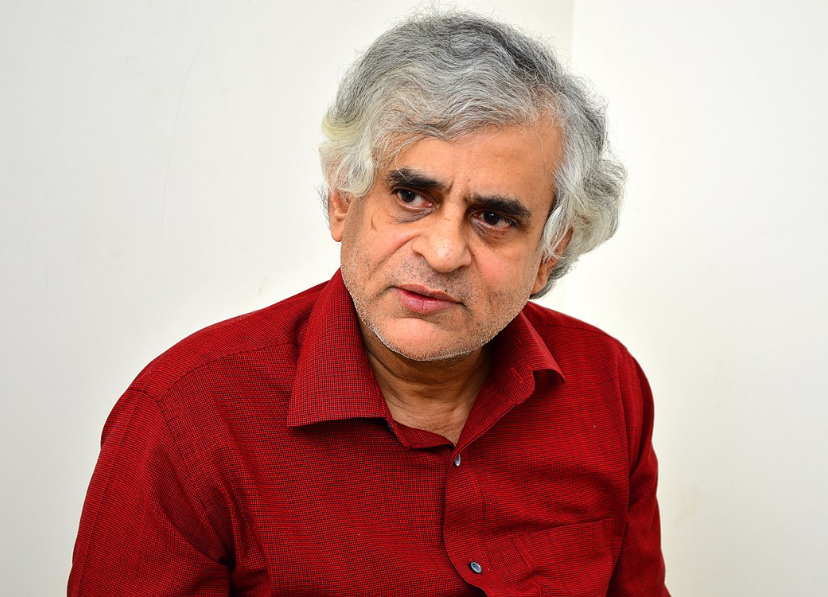𝐏. 𝐒𝐚𝐢𝐧𝐚𝐭𝐡 – 𝐓𝐡𝐞 𝐑𝐞𝐩𝐨𝐫𝐭𝐞𝐫 𝐖𝐡𝐨 𝐖𝐚𝐥𝐤𝐞𝐝 𝐭𝐡𝐞 𝐑𝐞𝐚𝐥 𝐈𝐧𝐝𝐢𝐚....
It was 1993 when P. Sainath did something no mainstream journalist dared to do: he left the comforts of city life and spent 270 days a year for decades reporting from rural India—on foot, in tractors, on motorcycles—across the country’s poorest districts
From Metro to Mud Roads
Born in Chennai in 1957, Sainath was no rural native—but he felt a profound disconnect between media narratives and the agony of villages his compatriots lived in . When he first stepped into areas ravaged by drought in Tamil Nadu, Bihar, MP, Odisha, and Uttar Pradesh, he realized: Poverty was not an act of nature—it was man-made .
With just a camera and his notebook, he exposed broken promises: schools without students; cows gifted to tribal families ending up in debt traps; dams built by uprooting entire communities for the profit of a few
The Book That Shook the Nation: Everybody Loves a Good Drought
In 1996, these stories were collected in Everybody Loves a Good Drought, a tightly woven tapestry of injustice and resilience. The title was sardonic—explaining how droughts became opportunities for graft. It became a Penguin classic, prescribed in hundreds of universities, and a catalyst for public debate.
One village, Chikapar, saw three evictions by various government agencies—each time, people lost land, homes, and hope, while contractors walked away with large sums. These weren’t distant problems—they were part of India's story.
𝐀𝐰𝐚𝐫𝐝𝐬, 𝐁𝐮𝐭 𝐍𝐨𝐭 𝐟𝐨𝐫 𝐄𝐠𝐨—𝐅𝐨𝐫 𝐀𝐜𝐜𝐨𝐮𝐧𝐭𝐚𝐛𝐢𝐥𝐢𝐭𝐲
Sainath’s uncompromising work earned him global recognition:
• Amnesty International’s Human Rights Journalism Prize, 2000
• Ramon Magsaysay Award, 2007 (for restoring rural lives to national focus)
Yet he lived modestly—without corporate backing—financing his early field trips even by selling personal possessions.
𝐁𝐮𝐢𝐥𝐝𝐢𝐧𝐠 𝐭𝐡𝐞 𝐏𝐞𝐨𝐩𝐥𝐞’𝐬 𝐀𝐫𝐜𝐡𝐢𝐯𝐞 𝐨𝐟 𝐑𝐮𝐫𝐚𝐥 𝐈𝐧𝐝𝐢𝐚 (𝐏𝐀𝐑𝐈)
In 2014, Sainath launched PARI, a digital, free-access platform dedicated to rural voices. It became a “living archive”—showcasing stories, videos, photos, and oral histories seldom covered by mainstream media.
Volunteer-driven and multilingual, PARI documents everything from forgotten crafts to agrarian distress. It’s not just journalism; it’s a collective memory—and a weapon against invisibility
𝐖𝐡𝐲 𝐒𝐚𝐢𝐧𝐚𝐭𝐡’𝐬 𝐒𝐭𝐨𝐫𝐲 𝐒𝐭𝐢𝐥𝐥 𝐈𝐧𝐬𝐩𝐢𝐫𝐞𝐬
• He redefined investigative journalism with emotional depth and factual courage .
• He reminded us that India’s soul lives in its villages, and must not be overlooked.
• He empowered us with the belief that a single journalist can spark systemic change.
𝐀 𝐖𝐚𝐥𝐤 𝐓𝐡𝐚𝐭 𝐂𝐡𝐚𝐧𝐠𝐞𝐝 𝐭𝐡𝐞 𝐆𝐫𝐨𝐮𝐧𝐝
P. Sainath didn’t just report—he walked through the droughts, debt, and dignity of rural India. He held up a mirror asking: What is development if it ignores those it claims to serve?
It was 1993 when P. Sainath did something no mainstream journalist dared to do: he left the comforts of city life and spent 270 days a year for decades reporting from rural India—on foot, in tractors, on motorcycles—across the country’s poorest districts
From Metro to Mud Roads
Born in Chennai in 1957, Sainath was no rural native—but he felt a profound disconnect between media narratives and the agony of villages his compatriots lived in . When he first stepped into areas ravaged by drought in Tamil Nadu, Bihar, MP, Odisha, and Uttar Pradesh, he realized: Poverty was not an act of nature—it was man-made .
With just a camera and his notebook, he exposed broken promises: schools without students; cows gifted to tribal families ending up in debt traps; dams built by uprooting entire communities for the profit of a few
The Book That Shook the Nation: Everybody Loves a Good Drought
In 1996, these stories were collected in Everybody Loves a Good Drought, a tightly woven tapestry of injustice and resilience. The title was sardonic—explaining how droughts became opportunities for graft. It became a Penguin classic, prescribed in hundreds of universities, and a catalyst for public debate.
One village, Chikapar, saw three evictions by various government agencies—each time, people lost land, homes, and hope, while contractors walked away with large sums. These weren’t distant problems—they were part of India's story.
𝐀𝐰𝐚𝐫𝐝𝐬, 𝐁𝐮𝐭 𝐍𝐨𝐭 𝐟𝐨𝐫 𝐄𝐠𝐨—𝐅𝐨𝐫 𝐀𝐜𝐜𝐨𝐮𝐧𝐭𝐚𝐛𝐢𝐥𝐢𝐭𝐲
Sainath’s uncompromising work earned him global recognition:
• Amnesty International’s Human Rights Journalism Prize, 2000
• Ramon Magsaysay Award, 2007 (for restoring rural lives to national focus)
Yet he lived modestly—without corporate backing—financing his early field trips even by selling personal possessions.
𝐁𝐮𝐢𝐥𝐝𝐢𝐧𝐠 𝐭𝐡𝐞 𝐏𝐞𝐨𝐩𝐥𝐞’𝐬 𝐀𝐫𝐜𝐡𝐢𝐯𝐞 𝐨𝐟 𝐑𝐮𝐫𝐚𝐥 𝐈𝐧𝐝𝐢𝐚 (𝐏𝐀𝐑𝐈)
In 2014, Sainath launched PARI, a digital, free-access platform dedicated to rural voices. It became a “living archive”—showcasing stories, videos, photos, and oral histories seldom covered by mainstream media.
Volunteer-driven and multilingual, PARI documents everything from forgotten crafts to agrarian distress. It’s not just journalism; it’s a collective memory—and a weapon against invisibility
𝐖𝐡𝐲 𝐒𝐚𝐢𝐧𝐚𝐭𝐡’𝐬 𝐒𝐭𝐨𝐫𝐲 𝐒𝐭𝐢𝐥𝐥 𝐈𝐧𝐬𝐩𝐢𝐫𝐞𝐬
• He redefined investigative journalism with emotional depth and factual courage .
• He reminded us that India’s soul lives in its villages, and must not be overlooked.
• He empowered us with the belief that a single journalist can spark systemic change.
𝐀 𝐖𝐚𝐥𝐤 𝐓𝐡𝐚𝐭 𝐂𝐡𝐚𝐧𝐠𝐞𝐝 𝐭𝐡𝐞 𝐆𝐫𝐨𝐮𝐧𝐝
P. Sainath didn’t just report—he walked through the droughts, debt, and dignity of rural India. He held up a mirror asking: What is development if it ignores those it claims to serve?
🌾 𝐏. 𝐒𝐚𝐢𝐧𝐚𝐭𝐡 – 𝐓𝐡𝐞 𝐑𝐞𝐩𝐨𝐫𝐭𝐞𝐫 𝐖𝐡𝐨 𝐖𝐚𝐥𝐤𝐞𝐝 𝐭𝐡𝐞 𝐑𝐞𝐚𝐥 𝐈𝐧𝐝𝐢𝐚....
It was 1993 when P. Sainath did something no mainstream journalist dared to do: he left the comforts of city life and spent 270 days a year for decades reporting from rural India—on foot, in tractors, on motorcycles—across the country’s poorest districts
From Metro to Mud Roads
Born in Chennai in 1957, Sainath was no rural native—but he felt a profound disconnect between media narratives and the agony of villages his compatriots lived in . When he first stepped into areas ravaged by drought in Tamil Nadu, Bihar, MP, Odisha, and Uttar Pradesh, he realized: Poverty was not an act of nature—it was man-made .
With just a camera and his notebook, he exposed broken promises: schools without students; cows gifted to tribal families ending up in debt traps; dams built by uprooting entire communities for the profit of a few
The Book That Shook the Nation: Everybody Loves a Good Drought
In 1996, these stories were collected in Everybody Loves a Good Drought, a tightly woven tapestry of injustice and resilience. The title was sardonic—explaining how droughts became opportunities for graft. It became a Penguin classic, prescribed in hundreds of universities, and a catalyst for public debate.
One village, Chikapar, saw three evictions by various government agencies—each time, people lost land, homes, and hope, while contractors walked away with large sums. These weren’t distant problems—they were part of India's story.
🏅 𝐀𝐰𝐚𝐫𝐝𝐬, 𝐁𝐮𝐭 𝐍𝐨𝐭 𝐟𝐨𝐫 𝐄𝐠𝐨—𝐅𝐨𝐫 𝐀𝐜𝐜𝐨𝐮𝐧𝐭𝐚𝐛𝐢𝐥𝐢𝐭𝐲
Sainath’s uncompromising work earned him global recognition:
• Amnesty International’s Human Rights Journalism Prize, 2000
• Ramon Magsaysay Award, 2007 (for restoring rural lives to national focus)
Yet he lived modestly—without corporate backing—financing his early field trips even by selling personal possessions.
📚 𝐁𝐮𝐢𝐥𝐝𝐢𝐧𝐠 𝐭𝐡𝐞 𝐏𝐞𝐨𝐩𝐥𝐞’𝐬 𝐀𝐫𝐜𝐡𝐢𝐯𝐞 𝐨𝐟 𝐑𝐮𝐫𝐚𝐥 𝐈𝐧𝐝𝐢𝐚 (𝐏𝐀𝐑𝐈)
In 2014, Sainath launched PARI, a digital, free-access platform dedicated to rural voices. It became a “living archive”—showcasing stories, videos, photos, and oral histories seldom covered by mainstream media.
Volunteer-driven and multilingual, PARI documents everything from forgotten crafts to agrarian distress. It’s not just journalism; it’s a collective memory—and a weapon against invisibility
🌟 𝐖𝐡𝐲 𝐒𝐚𝐢𝐧𝐚𝐭𝐡’𝐬 𝐒𝐭𝐨𝐫𝐲 𝐒𝐭𝐢𝐥𝐥 𝐈𝐧𝐬𝐩𝐢𝐫𝐞𝐬
• He redefined investigative journalism with emotional depth and factual courage .
• He reminded us that India’s soul lives in its villages, and must not be overlooked.
• He empowered us with the belief that a single journalist can spark systemic change.
𝐀 𝐖𝐚𝐥𝐤 𝐓𝐡𝐚𝐭 𝐂𝐡𝐚𝐧𝐠𝐞𝐝 𝐭𝐡𝐞 𝐆𝐫𝐨𝐮𝐧𝐝
P. Sainath didn’t just report—he walked through the droughts, debt, and dignity of rural India. He held up a mirror asking: What is development if it ignores those it claims to serve?
0 Comments
0 Shares
4K Views
0 Reviews







